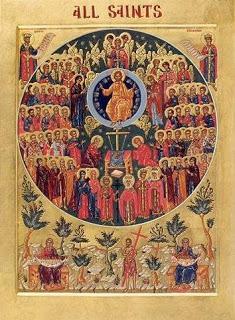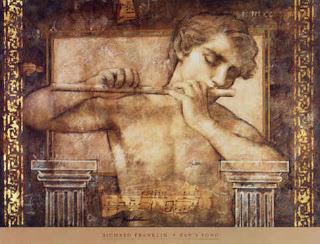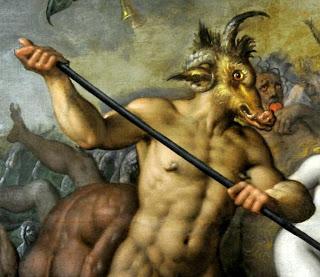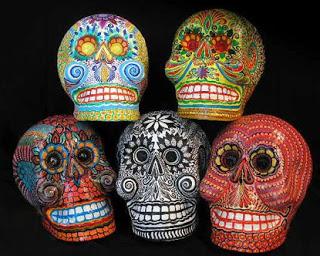 All Saint's Day
All Saint's DayIn the Roman Catholic religion All Saint's Day, or Hallomas, began as a celebration in the form of a Feast honoring more than 10,000 saints, many of whom were persecuted during the period of late Roman rule. Traditionally celebrated on May 13 and 14, All Saint's Day and All Soul's Day were moved to November 1st and 2nd in the 8th Century by Pope Gregory III to coincide with the Celtic/Gaelic (or Pagan as some consider) harvest celebration of Samhain. It was not unusual for the Church to relocate its Holidays to coincide with pagan holidays in order to convert them to Christianity. Christmas was officially set to December 25th to coincide with the Winter Solstice celebration of the Celts.
All Soul's Day
All Soul's Day was initiated the day after Hallomas to specifically honor and pray for Christian souls in purgatory. Suffering and repentance plays a big role in Catholicism and it is believed that many souls end up in a place of repentance before they can enter Heaven, and that it is the role of those Christians left behind to pray them on to Heaven. Good works can also be performed to offset the sins of loved ones.
The idea of wandering Spirits was an unchristian idea but the Church could not rid people of this supernatural belief. By the early 300 C.E. period, the ancient Greek God, Pan, and the ancient Celtic God, Cernunnos were still worshipped by many throughout Europe and the Mediterranean countries and the Church began its demonization campaign of these pagan gods.
Celts, Greeks, Ancient Cultures and Christianity
 Cernunnos is the only pre-Roman, free-Celtic period spiritual deity. He was depicted in rock inscriptions as having stag horns and hooves and usually accompanied by a horned stag and horned snake. The earliest recorded depiction is on a 4th century B.C.E. rock carving at Paspardo in Camonica Valley in Northern Italy. On the Gundestrup Cauldron which dates as early as 4th to 3rd century B.C.E., Cernunnos appears cross-legged with two twisted torcs (Celtic neck rings - necklaces) and antlers and is accompanied by the stag and snake mentioned above. In following centuries, he's depicted with many other types of animals and "beasts" of the day.
Cernunnos is the only pre-Roman, free-Celtic period spiritual deity. He was depicted in rock inscriptions as having stag horns and hooves and usually accompanied by a horned stag and horned snake. The earliest recorded depiction is on a 4th century B.C.E. rock carving at Paspardo in Camonica Valley in Northern Italy. On the Gundestrup Cauldron which dates as early as 4th to 3rd century B.C.E., Cernunnos appears cross-legged with two twisted torcs (Celtic neck rings - necklaces) and antlers and is accompanied by the stag and snake mentioned above. In following centuries, he's depicted with many other types of animals and "beasts" of the day. He was the "Lord" or leader of animals and could shape-shift, or become any of the animals which made him a man/God and animal as he could easily be either.
He was the "Lord" or leader of animals and could shape-shift, or become any of the animals which made him a man/God and animal as he could easily be either.Similarly, the Greek God, Pan (pictured left), was depicted as half man/half animal. He was a shepherd, played pipes and loved nature. Ancient cultures recognized that life and Nature went hand-in-hand. Cycles were observed of life, death and rebirth as in the seasons when life would die and regenerate in Spring. It was a fact that Pan was the most popular Greek God as stated here: "It's a fact that there are more dedications to him than to any other..." (Pitt-Kethley xi).
As Rome began to convert the Celts, Greeks and other cultures to Christianity, they introduced a new man/God, Jesus, and demonized the old man/Gods as the devil. Thus, we find the devil always depicted as Cerunnos or Pan - with horns and hooves. This demonization was no accident, but rather a deliberate twisting of pagan ideals as Christianity spread its influence throughout Europe.
After the Council of Nicea issued the Nicene Creed and the Roman Catholic Church was established in 325 C.E., Christian theologians (beginning with Eusebius) transformed Pan from a benign nature god to Satan, the great Adversary....because he was an adversary to the Church. He was the competition and the major challenge to converting the masses.
 The only issue the Church had with melding these man/Gods into Christianity was how to create an emergence of the ultimate man/God without allowing the reproductive aspects of these gods to come through. Nature is prolific and so were Cernunnos and Pan. Most times they were depicted with phallic symbols, representing fertility. This presented a quandary in converting the old belief systems into a new one. The Church believed it needed to control what they perceived to be hedonistic behavior - sexuality. Taking up most of the first millennium, the Church achieved success.
The only issue the Church had with melding these man/Gods into Christianity was how to create an emergence of the ultimate man/God without allowing the reproductive aspects of these gods to come through. Nature is prolific and so were Cernunnos and Pan. Most times they were depicted with phallic symbols, representing fertility. This presented a quandary in converting the old belief systems into a new one. The Church believed it needed to control what they perceived to be hedonistic behavior - sexuality. Taking up most of the first millennium, the Church achieved success.
In order to demonize the Gods and substitute Jesus it had to make the nature of us as sexual beings taboo and in doing so demonized women as dirty temptresses in the process. But the Church was patient to achieve it's goals of control. During the Renaissance period, Greek and ancient Roman gods began to regain some of their fame. The Church was anxious to prevent Pan from slipping back into his harmless nature, and so commissioned works of art appropriately: "Pan's knobbly horns...took on a newly, diabolic meaning in Christian art...such examples are not "misinterpretations" of classical content but purposeful...Christian diabolization of pagan forms" (Camille 103) (Above photos Christian art 1580's period)
Dia de los Muertos - Day of the DeadIt is, therefore, no surprise to find Dia de los Muertos or Day of the Dead also celebrated on November 1st. Primarily celebrated in Mexico, Day of the Dead is the celebration of loved ones who have passed on. The Mayans, Aztecs, Incans and other Central and South American have gotten a "bad rap". When the Spanish Conquistadors arrived in what is now known as Mexico, they found the natives practicing a ritual they perceived as mocking death. The Aztecs would kept skulls of loved ones as trophies which were used to represent death and rebirth in this ritual. Unlike the SC's who viewed death as the end of life the Aztecs seemed to embrace death as a continuation of life. "The pre-Hispanic people honored duality as being dynamic" states Christina Gonzalez, senior lecturer on Hispanic issues at Arizona State University. "They didn't separate death from pain, wealth from poverty like they did in Western cultures."
In the process of converting these cultures to Catholicism the Spaniards found it a challenge to stop the ritual. Their solution was to move the date to that of All Saint's and All Soul's Day November 1st and 2nd from it's original date of the beginning of August. (Sound familiar?)

Dia de los Muertos is a colorful celebration of their loved ones. Decorating skulls still plays an important role in this celebration which may seem dark and ominous to the observer. Much of Mexico is now christian so today's celebration, while retaining it's tradition, is a combination of the pre-Hispanic and Catholic tradition.
Celebrate!
Regardless of religious affiliation, culture, genealogy and traditions November 1st is a day of celebration. It's a day of celebration of life, death and rebirth. Whether celebrating and honoring people past or honoring Nature, today is the day to celebrate and remember life.
"For life and death are one, even as the River and the Sea are one." ~Kahlil Gibran

